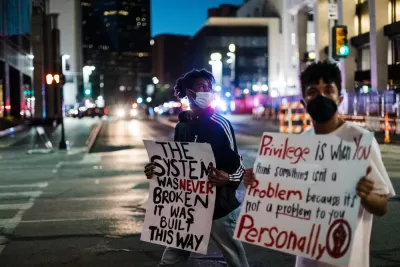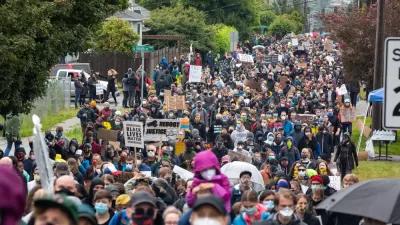In Dallas, Dr. Eric Anthony Johnson is not letting last year's crises go to waste.

Dr. Eric Anthony Johnson was up for a challenge when he stepped into his new job as chief of economic development and neighborhood services for Dallas, Texas. It was early March 2020 and—fresh from a stint as community development director in Bloomington, Minnesota—Johnson was eager to apply his skills in the nation's ninth-largest city.
Needless to say, Johnson's challenges soon multiplied. In the past year, Dallas—like other American cities—has reeled from multiple crises. First came the pandemic and, on its heels, a recession that cost the city 300,000 jobs over the course of a year. Then came civic and social unrest after George Floyd's murder. Most recently, Dallas faced a historic cold snap followed by power outages and massive infrastructure failures.
It’s been a year that calls for new approaches, and Johnson is responding to the challenge. Here, he talks with Laurie Mazur of the Island Press Urban Resilience Project about the challenges he has faced, and his vision for surmounting them.
Mazur: So, it's been quite a year. How are you coping?
Johnson: I'm coping really well, quite honestly. Because as strange as that may sound, the events of the last year have allowed for greater strategic thinking—really connecting the dots so that we come out on the other side in a stronger position.
Mazur: Tell me about the dots you are connecting. What's in your portfolio?
Johnson: My portfolio consists of economic development, housing, urban planning, historic preservation, and sustainable development and construction. Those are big entities in the city of Dallas. So it was already going to require me to hit the ground running. And as soon as I got here, the pandemic hit.
On day one, I had to create an immediate recovery strategy to help small businesses and families who could not pay the rent because of COVID-19. So I helped create a small business continuity fund and a rental and mortgage assistance program. That was the first thing out of the gate.
Then we started connecting the dots through something called the Community Transformation Action Roadmap, which came out of discussions with stakeholders in the community. In the context of the pandemic, social unrest, limited resources, and growing housing problems, we asked: What are we going to do? We stepped back, and looked at the components we did not have, and used this opportunity to put some new building blocks in place.
Mazur: What are those building blocks?
Johnson: One thing we realized during the pandemic was that we cannot rely on the city's traditional resources to do our work. We need more money for affordable housing in Dallas, which is at an epidemic level in terms of need, but that's not going to work when the tax base is down. So how do we create resources beyond the general fund?
So we are leveraging our limited dollars to draw in corporate and philanthropic support. Soon we'll be asking the council to approve an Affordable Housing Revolving Loan Program. We're putting in $6 million in public funds to create the fund, which will be managed by a public-private partnership. The partnership will raise funds to support the fund’s growth and underwrite affordable housing projects. The public dollars are a credit enhancement that signals to the private financial community that it's okay to invest, because we have reserves to cover any losses.
It's about disruptive thinking—thinking outside the box versus the traditional approaches. We don't have a lot of money, so what's the best way to leverage what we have to draw in other support? Because it's just not the city's responsibility to provide housing, it's everyone’s responsibility. You can't have strong economic growth without stable housing. Instead of saying, 'We don't have any money. We need the federal government to come help, or we need to raise taxes to do it.' I just don't see that being possible in reality.
Mazur: You say that stable housing is key to economic growth. Most cities try to grow their local economies by luring corporate employers. But you've taken a different tack, by focusing on economic and racial inequality. Tell me about your approach.
Johnson: For most cities, economic development is like fishing: you throw your line out and try to catch something and reel it in. But then you get into this battle over who has the most they can throw at companies.
We want to focus on our brand. We want to create a powerful brand for Dallas as a city that values and invests in all of its residents. Right now, there is a lot of inequality in this city. About 85% of the city's tax base is in the north side of the city; just 15% is in the south, in the neighborhoods where people of color live. Carrying that level of inequality is going to restrict Dallas from maximizing its potential.
But these approaches don't have to be mutually exclusive. You can have your traditional economic development, which focuses on business recruitment, retention, and things of that nature. At the same time, you can build communities from the ground up by focusing on things like enhanced workforce development; targeting resources to underserved areas to create incubators and innovation centers; and working with people in the community to build their skill sets and start businesses. Doing all of that together gives you a concrete, comprehensive approach.
Mazur: So how do you implement that approach?
Johnson: The Roadmap includes a new economic development policy that combines both the traditional and the community aspect into one approach. In April, we are bringing a draft of that policy to the council. The policy is a ten-year document with high-level goals and objectives designed to both increase the tax base and reduce inequality in Dallas. It's going to talk about hitting certain metrics around housing, living wages, corporate recruitment, entrepreneurship, and infrastructure.
We're also launching a new economic development entity to give us greater flexibility to do comprehensive economic development. The new entity will be able to go into southern Dallas, where the inequality exists, and assemble land, package it, put in infrastructure, and shop it around to companies that can create jobs.
So that's an important building block. It makes us more competitive by allowing us to move at the speed of business. It also helps us make a strong business case for underserved areas in south Dallas, where most of the city's future growth will be. The new development entity will remove some obstacles to developing those areas, and it also gives us the ability to establish really good public-private and community partnerships to move toward meeting the metrics in the policy.
Mazur: Dallas is certainly not the only city that's reeling from the events of the last year. All over the country, city officials are dealing with growing needs and shrinking resources. What have you learned from your work in Dallas and also elsewhere that can apply to other cities?
Johnson: In light of the pandemic, and the growing social and economic inequalities, what I've learned over the last year or so is that we need disruptive leaders in the public sector. I'm not talking about revolution; I'm talking about disruption in the sense of thinking differently. You have to respond at the speed of the issues that are coming at you. You have to respond in the context of not having much to work with. You have to respond in the context of having multiple stakeholders. And it's not enough to say, 'Let's wait for the storm to pass and let's see what happens after that.'
This moment provides a great opportunity to really test your skill set and do some creative work. You have a choice. You can sit and say, well, we've always been doing it this way; it is what it is. Or you can use this window of opportunity to think differently about the challenges we face, because the challenges are going to always be here. And I think these challenges are going to come even more rapidly. That's why we need to put the pieces in place that can help us be more responsive.
Mazur: Well, I hate to quote Milton Friedman, but he was on to something when he said, 'never let a good crisis go to waste.' Sounds like you're not wasting this crisis.
Johnson: No, I'm not wasting the crisis. And I think he's absolutely right. But you have to be willing to take some risks. You can't just keep your head down, protecting your job. You have to be willing to put something on the table, put something on the line. People respect the fact that you're willing to do something different. You may not get it all right, but you are trying something. Policy makers appreciate that. And people in the community will come to the table. Because the work is so much greater than just the city. It's the community that brings the work to life.
[This interview was conducted in March 2021 and was lightly edited for clarity.]

Study: Maui’s Plan to Convert Vacation Rentals to Long-Term Housing Could Cause Nearly $1 Billion Economic Loss
The plan would reduce visitor accommodation by 25,% resulting in 1,900 jobs lost.

North Texas Transit Leaders Tout Benefits of TOD for Growing Region
At a summit focused on transit-oriented development, policymakers discussed how North Texas’ expanded light rail system can serve as a tool for economic growth.

Why Should We Subsidize Public Transportation?
Many public transit agencies face financial stress due to rising costs, declining fare revenue, and declining subsidies. Transit advocates must provide a strong business case for increasing public transit funding.

How to Make US Trains Faster
Changes to boarding platforms and a switch to electric trains could improve U.S. passenger rail service without the added cost of high-speed rail.

Columbia’s Revitalized ‘Loop’ Is a Hub for Local Entrepreneurs
A focus on small businesses is helping a commercial corridor in Columbia, Missouri thrive.

Invasive Insect Threatens Minnesota’s Ash Forests
The Emerald Ash Borer is a rapidly spreading invasive pest threatening Minnesota’s ash trees, and homeowners are encouraged to plant diverse replacement species, avoid moving ash firewood, and monitor for signs of infestation.
Urban Design for Planners 1: Software Tools
This six-course series explores essential urban design concepts using open source software and equips planners with the tools they need to participate fully in the urban design process.
Planning for Universal Design
Learn the tools for implementing Universal Design in planning regulations.
City of Santa Clarita
Ascent Environmental
Institute for Housing and Urban Development Studies (IHS)
City of Grandview
Harvard GSD Executive Education
Toledo-Lucas County Plan Commissions
Salt Lake City
NYU Wagner Graduate School of Public Service





























